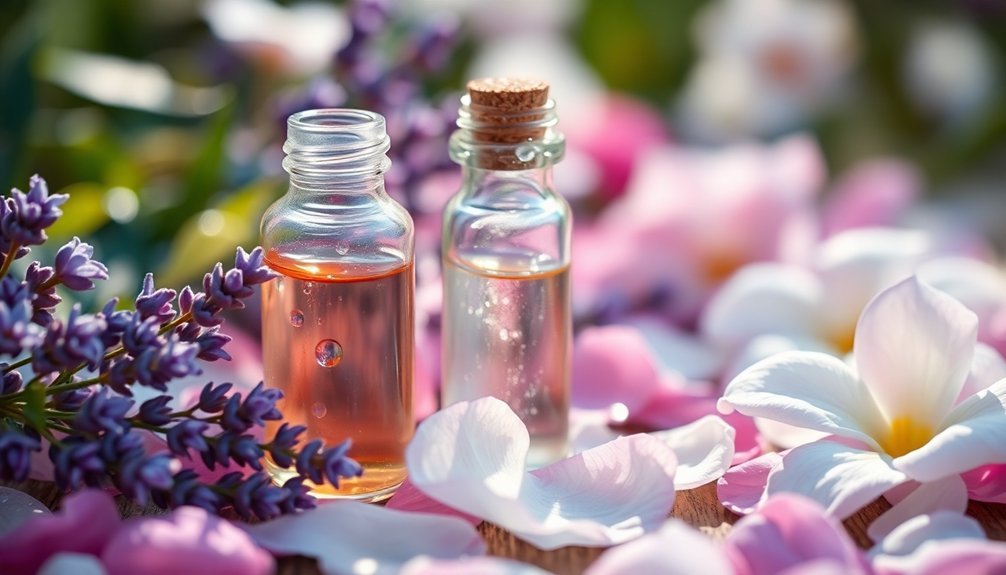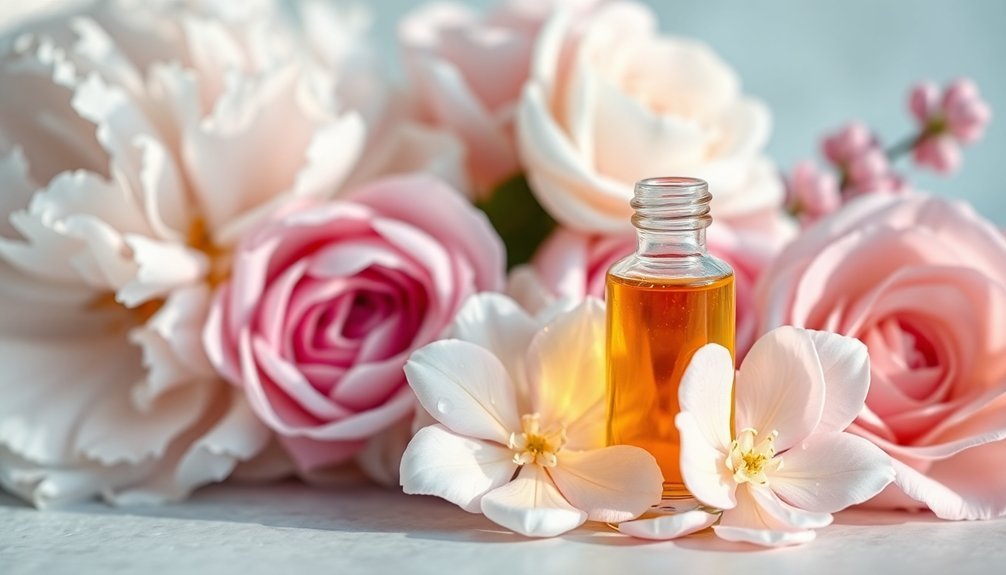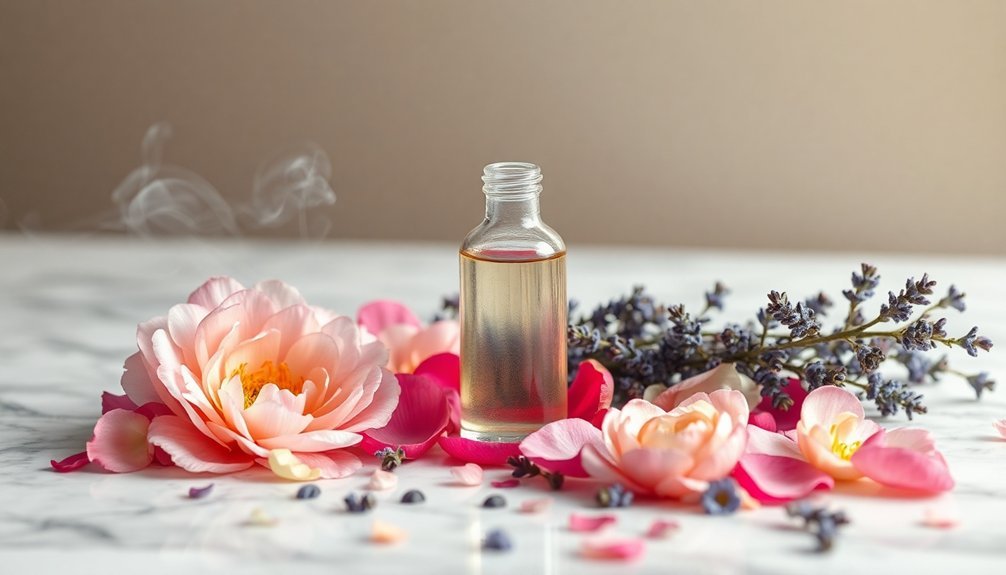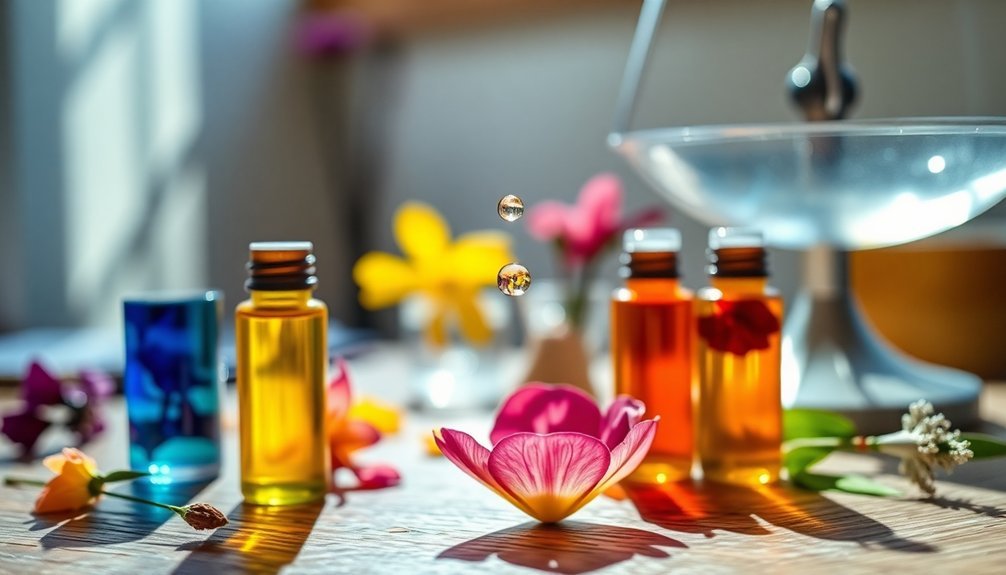When you're working with soft floral essential oils, balance isn't just important—it's essential. These delicate oils require precise ratios because even one extra drop can overpower the entire blend. You'll need to carefully combine your top notes (30%), middle notes (50%), and base notes (20%) to create a harmonious fragrance that lasts. Whether you're blending rose, lavender, or jasmine, mastering this delicate equilibrium will transform your aromatic creations from overwhelming to extraordinary. The art of perfect balance awaits your discovery.
Understanding the Delicate Nature of Floral Essential Oils

While many essential oils are known for their robust nature, floral essential oils stand apart due to their delicate composition and intricate extraction processes.
You'll find that extracting these precious oils requires immediate handling and meticulous care, with thousands of petals needed for just a small amount of oil. For instance, you'll need 10,000 rose petals to produce a single pint of rose essential oil.
The delicate nature of these oils is evident in their unique chemical compositions and extraction methods. Magnolia essential oil production especially demonstrates this delicacy, requiring careful handling of petals during the entire distillation process.
Whether it's the steam distillation of rose and neroli or the CO2 extraction of jasmine, each process must preserve the flower's subtle aromatic compounds.
From Bulgaria's Kazanlak Valley roses to Morocco's bitter orange blossoms, these oils capture nature's most refined essences through carefully controlled extraction techniques.
The Science Behind Top, Middle, and Base Note Harmony
To create a harmonious floral oil blend, you'll need to understand how different aromatic compounds interact through a three-tiered structure of top, middle, and base notes.
The balance starts with bright, fresh top notes that evaporate within minutes, setting your blend's initial impression. Success depends on compatible scent combinations when selecting these opening notes.
Middle notes, making up 50-75% of your blend, emerge as the top notes fade, delivering the heart of your fragrance through floral elements like rose or jasmine.
Your base notes, though only 5-10% of the mixture, provide essential anchoring through woody or rich elements like sandalwood or vanilla.
When you combine these layers thoughtfully, they'll create a synergistic effect where each note complements the others, resulting in a more sophisticated and longer-lasting floral blend that unfolds beautifully on the skin.
Creating the Perfect Ratio for Soft Floral Blends

Creating soft floral blends starts with mastering the 30-50-20 rule, a time-tested formula that builds upon the basic principles of fragrance layering.
You'll want to dedicate 30% of your blend to top notes like bergamot or sweet orange, 50% to middle notes such as rose geranium or lavender, and 20% to base notes like ylang ylang or sandalwood.
For a 20-drop blend, you'd use 6 drops of top notes, 10 drops of middle notes, and 4 drops of base notes. Understanding that lighter molecules evaporate quickly helps explain why top notes require more frequent reapplication.
When combining oils, start with classic pairings like rose and lavender or geranium and ylang ylang. Let your blend rest for 48 hours to mature, and document your ratios for consistency.
Remember to balance strong oils with milder ones to maintain the soft, delicate character you're seeking.
Common Mistakes When Blending Floral Oils
When crafting soft floral blends, you'll want to be mindful not to overuse geranium oil, as its potent aroma can quickly overwhelm more delicate floral notes.
You're likely to achieve better results by starting with small amounts of geranium and gradually increasing until you reach the desired balance.
Don't forget to incorporate adequate base notes, which provide the foundation that helps your floral blend remain stable and well-rounded.
Using Too Much Geranium
Although geranium essential oil offers wonderful therapeutic benefits, using too much can quickly overwhelm your entire blend. Even a tiny amount can dominate other essential oils, making it difficult to achieve the soft, balanced floral scent you're aiming for.
You'll want to be especially careful when combining geranium with oils like bergamot, lavender, or clary sage, as it can easily overshadow their subtle notes.
Consider using rose geranium instead if you find regular geranium too potent, as it has a cleaner, more floral scent. If you've already added too much geranium, try balancing it with spicy notes like ginger, cinnamon, or cardamom.
Remember to follow proper dilution ratios – for adults, use 15 drops per 6 teaspoons of carrier oil, and considerably less for children.
Forgetting Base Note Balance
Base notes serve as the foundation of any successful floral oil blend, yet many beginners overlook their essential role in creating lasting fragrances. If you don't include enough base notes in your blend, you'll end up with a fragrance that dissipates too quickly and lacks depth.
Remember to follow the 30/50/20 rule, allocating 20% of your blend to base notes like Frankincense, Patchouli, or Sandalwood. You can split this percentage between multiple base oils to create more complex aromas.
When you're working with florals, try pairing them with complementary base notes – for example, Sandalwood works beautifully with floral scents, adding a smooth, woody undertone. Without proper base note balance, your blend won't have the grounding element it needs, and you'll find your top and middle notes becoming overwhelming or fading too fast.
Balancing Strong Florals With Complementary Scents

To tame the intensity of strong floral oils, you'll find that citrus notes like tangerine create a lighter, more approachable blend.
Adding middle notes such as geranium builds complexity and depth, creating a more nuanced fragrance profile.
Ground your floral blends with earthy base notes, which provide stability and prevent the florals from becoming too dominant in your final creation.
Citrus Softens Strong Florals
When strong floral fragrances threaten to overwhelm your senses, citrus notes provide the perfect counterbalance. By adding bright, uplifting oils like grapefruit, mandarin, or orange blossom, you'll transform intense florals into beautifully balanced blends. The citrus components act as top notes, creating an immediate fresh impact while allowing the floral notes to develop more gradually.
You'll find citrus effectively softens strong florals in several ways:
- Creates a harmonious contrast between bright top notes and rich middle notes
- Provides an invigorating quality that prevents heaviness
- Evaporates quickly, leaving behind a softer floral presence
- Adapts to your skin chemistry for personalized results
- Works especially well with geranium and ylang ylang
Test your blends on your skin to discover how the citrus and floral notes interact over time.
Middle Notes Add Depth
Middle notes serve as the heart and soul of your floral blends, creating essential depth and character once the initial top notes fade away. You'll find that balancing strong florals requires careful consideration of complementary scents to achieve the perfect harmony.
| Strong Florals | Ideal Complements |
|---|---|
| Rose & Jasmine | Neroli, Lavender |
| White Petals | Warm Woods, Amber |
| Tuberose | Spices, Bergamot |
To create sophisticated blends, you'll want to pair dominant floral notes with softer elements. Try combining rose with violet and cardamom for a spicy dimension, or blend jasmine with neroli for a more refined profile. Adding green notes like pine or eucalyptus can provide invigorating contrast, while woody or oriental notes will introduce sensuality to your composition.
Grounding With Base Notes
Base notes anchor your floral blend by providing a deep, enduring foundation that lasts up to 24 hours.
When you're balancing strong florals like jasmine or rose, you'll need these rich, grounding elements to create harmony and prevent overwhelming scents.
Add about 20% base notes to your blend for ideal results.
The most effective base notes for floral blends include:
- Patchouli – earthy and musky, offering strong grounding properties
- Sandalwood – warm and woody with meditative qualities
- Vetiver – deep and smoky, providing stability
- Galax – adds depth and lasting power
- Ylang extra – enhances the blend's lingering qualities
Let your blend rest for 24 hours to allow the oils to marry properly.
Always test on a small patch of skin to verify compatibility before full application.
Therapeutic Benefits of Well-Balanced Floral Combinations
Through careful selection and blending of floral essential oils, you'll discover powerful therapeutic benefits that support both emotional and physical wellness.
For emotional balance, combine lavender's soothing properties with melissa's mood-lifting effects, or pair jasmine's heart-opening qualities with neroli's stabilizing influence.
You can create targeted blends for physical health by mixing German chamomile's anti-inflammatory properties with sweet marjoram's muscle-relieving effects.
For skin care, blend helichrysum's healing compounds with lavender's antimicrobial benefits to address damaged or troubled skin.
When you're looking to enhance sleep quality, try combining lavender with Roman chamomile.
For respiratory support and mental clarity, mix rosemary with eucalyptus, creating a blend that'll both energize and clear your mind.
Testing and Adjusting Your Floral Oil Blend

When creating your floral oil blend, you'll need to carefully evaluate each oil's aroma strength to achieve a balanced composition.
Start by testing each oil individually on perfume strips, noting how dominant or subtle each scent appears. You can apply the 30/50/20 rule to maintain harmony while adjusting for aroma strength differences.
- Fan multiple perfume strips to experience how the oils interact together
- Consider using more drops of softer florals like lavender to balance stronger scents
- Start with a 100-drop base to calculate precise percentages for each oil
- Choose oils from complementary fragrance families for natural harmony
- Test the blend on an aroma wand before finalizing your composition
Remember that if your initial blend isn't perfect, you can continue adjusting the ratios until you achieve your desired balance.
Frequently Asked Questions
Can Floral Oil Blends Affect Pets Differently Than Humans?
Yes, your pets will react more strongly to floral oil blends than you do. Their sensitive noses have millions more scent receptors, and their bodies can't process oils the same way yours does.
How Long Do Homemade Floral Essential Oil Blends Typically Stay Fresh?
Your homemade floral essential oil blends will typically stay fresh for 1-2 years if you've stored them properly in dark bottles, away from heat and light. Adding base notes can extend their shelf life.
Do Seasonal Changes Impact the Effectiveness of Floral Essential Oil Blends?
Yes, seasonal changes considerably impact your floral blends. You'll notice varying evaporation rates and scent stability due to temperature and humidity shifts. You'll need to adjust ratios throughout the year for ideal effectiveness.
Which Carrier Oils Best Preserve the Delicate Notes of Floral Blends?
You'll find jojoba oil is your best choice for preserving floral notes due to its neutral scent and long shelf life. Sweet almond oil's mild profile and rosehip's antioxidant properties make excellent secondary options.
Can Floral Essential Oil Blends Stain Clothing or Furniture?
Yes, you'll find that floral essential oil blends can stain both clothing and furniture. You should always dilute oils properly and test on a small area first to prevent permanent marks on fabrics.
In Summary
You've learned that creating soft floral oil blends requires precision, patience, and understanding of scent profiles. Remember to start with small amounts, test your blends thoroughly, and don't rush the process. When you've achieved that perfect balance between top, middle, and base notes, you'll have a harmonious blend that's both therapeutic and beautifully fragrant. Keep experimenting and trust your nose – it's your best guide.
References
- https://www.clarityblend.com/blogs/our-journal/mastering-aromatherapy-the-art-of-top-middle-and-base-notes-in-essential-oil-blends
- https://www.tn.gov/content/dam/tn/education/textbook/samples/sec_E_SB_ELA_G6.pdf
- https://www.newdirectionsaromatics.com/blog/categories-of-essential-oils-their-benefits/
- https://www.hbs.edu/faculty/Pages/profile.aspx?facId=6532
- https://wildgroveessentials.com/blogs/blog/floral-but-not-too-floral-the-process-of-creating-a-balanced-essential-oil-blend
- https://miraclebotanicals.com/a/blog/spend-this-summer-in-full-bloom
- https://www.newdirectionsaromatics.com/blog/the-theory-practice-of-essential-oil-blending/
- https://www.ellemental.com/330-floral
- https://www.aromatics.com/blogs/wellness/heart-notes-how-floral-essential-oils-nurture-emotions
- https://www.rockymountainoils.com/collections/floral-essential-oils
- https://botaniesoap.com/blogs/misc/notes-fragrance-music
- https://www.edensgarden.com/blogs/news/understanding-top-middle-and-base-notes-in-perfume
- https://us.florislondon.com/blogs/news/what-are-top-middle-and-base-notes-in-perfume
- https://banterandbliss.com/blogs/news/unveiling-the-art-of-fragrance-accords-the-harmony-of-top-middle-and-base-notes
- https://www.diffuserworld.com/grouping-and-mixing-your-own-essential-oil-blends
- https://mockingbirdapothecary.com/blogs/mockingbird-blog/crafting-perfect-scents-an-essential-oils-blending-guide-for-beginners
- https://ascensionkitchen.com/make-your-own-perfume-with-essential-oils/
- https://www.soapmakingforum.com/threads/floral-perfumey-essential-oil-blend.93228/
- https://magnadea.com/blogs/acta-diurna/how-to-blend-essential-oils-example-blends-to-try
- https://achs.edu/blog/blending-101-the-art-of-pairing/





Leave a Reply